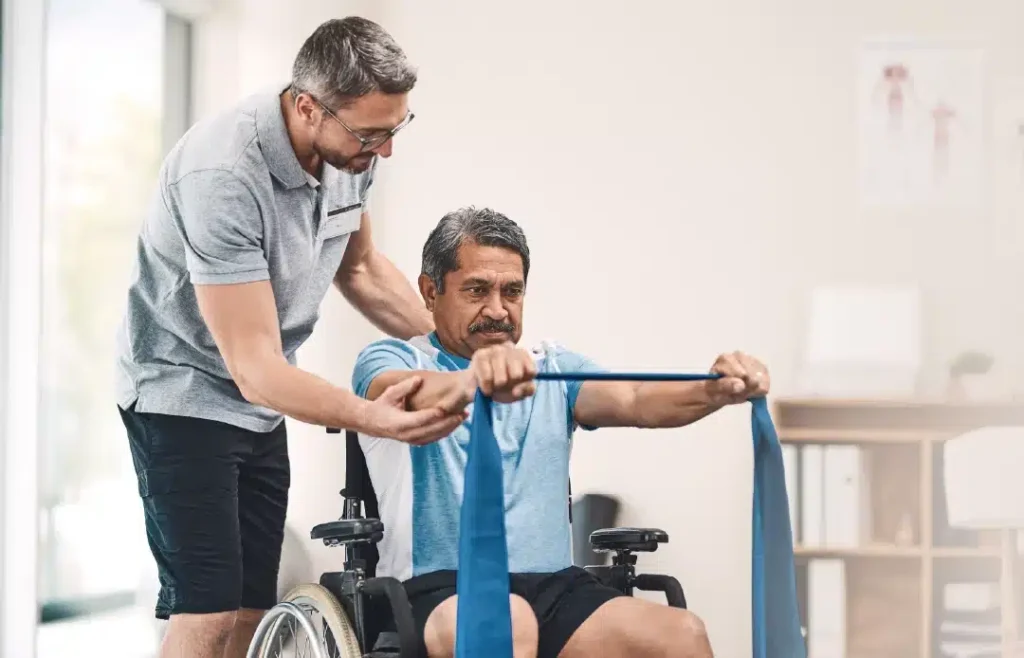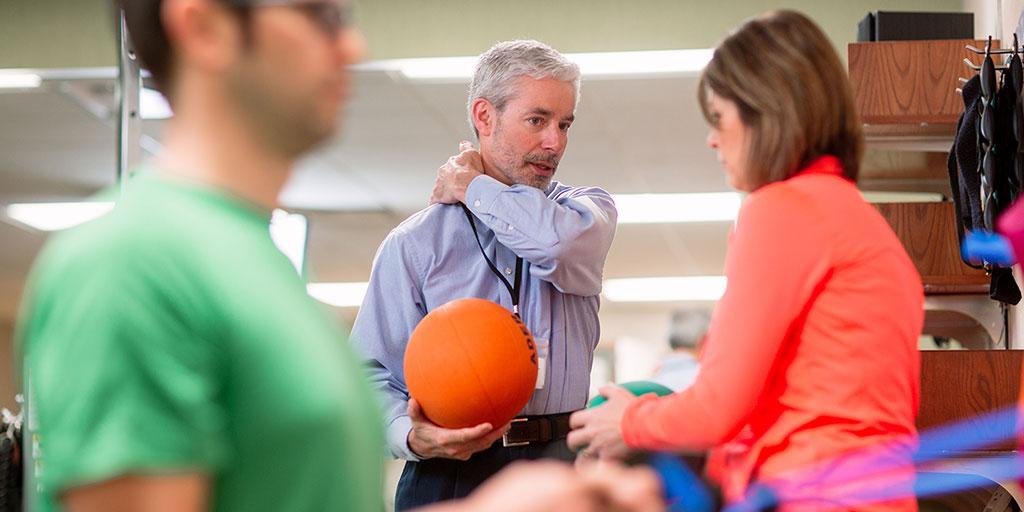Physical therapy (PT) is often the key to recovering from injury, surgery, or chronic conditions that affect mobility and strength. It’s not just about exercises; it’s a holistic approach to healing that empowers individuals to regain independence and improve their quality of life. This article explores the transformative power of physical therapy, its various techniques, benefits, and the role it plays in unlocking the path to recovery.
Key Takeaways
- Physical therapy is a personalized approach to treating pain, injuries, and chronic conditions by targeting specific exercises and techniques for recovery.
- Pain management and the restoration of mobility are two of the most significant benefits of physical therapy.
- Physical therapy is not just about exercises; it includes manual therapy, education, and prevention strategies to help patients return to normal function and avoid future injuries.
- Modern technology plays a key role in enhancing physical therapy treatments, from virtual reality to telehealth, making recovery more efficient and accessible.
- Consistency and patience are crucial in the rehabilitation process, as physical therapy often requires time and effort to see lasting results.
What Is Physiotherapy?
Physiotherapy is a healthcare profession that focuses on assessing, diagnosing, and treating a wide range of physical conditions and injuries.
It aims to improve a person’s mobility, function, and overall quality of life through evidence-based techniques and personalised treatment plans.
Physiotherapists work closely with patients to develop individualised strategies for rehabilitation, pain management, and injury prevention.
The Role of Physiotherapists

Physiotherapists are highly skilled healthcare professionals who undergo rigorous training in the assessment and treatment of various musculoskeletal, neurological, and cardiopulmonary conditions.
They possess a deep understanding of human anatomy, physiology, and biomechanics, enabling them to provide tailored treatment plans for their patients.
Physiotherapists work in various settings, including hospitals, private clinics, sports clubs, and community centres, catering to a diverse population of patients.
A Brief History
Physiotherapy has a rich history dating back to ancient times when early civilisations, such as the Greeks and Egyptians, utilised massage and hydrotherapy to treat various ailments.
In the late 19th century, the modern physiotherapy profession began to take shape, with the founding of the Chartered Society of Physiotherapy in the UK in 1894.
Over time, physiotherapy has evolved into a highly specialised profession, incorporating evidence-based techniques and cutting-edge research to deliver effective treatment options for patients.
Understanding Physical Therapy
Physical therapy is a healthcare specialty focused on helping individuals improve their movement and manage pain. It is commonly used to treat conditions that affect the musculoskeletal system—muscles, joints, bones, and nerves. By incorporating targeted exercises, hands-on techniques, and advanced technologies, physical therapists assist patients in regaining strength, mobility, and overall physical function.
The journey of physical therapy is one that requires commitment, patience, and perseverance, but it is incredibly effective in restoring movement and healing the body. Whether recovering from an injury, surgery, or managing a chronic illness, physical therapy offers an individualized approach to treatment that promotes recovery and overall well-being.
The Key Benefits of Physical Therapy
- Pain Management Chronic pain or pain following an injury can often be alleviated or significantly reduced through physical therapy. By using specialized techniques, such as manual therapy, therapeutic exercises, and modalities like heat or ice, physical therapists can help patients manage pain and improve their function.
- Improved Mobility and Flexibility Whether recovering from an injury or managing a condition such as arthritis, physical therapy plays a critical role in improving flexibility and range of motion. Stiffness, swelling, and muscle weakness can limit movement, but targeted exercises and stretching can restore normal mobility and movement patterns.
- Strengthening and Endurance Recovery from injury or surgery often involves building strength in specific muscle groups that were weakened or injured. Physical therapy helps patients target the right muscle groups to build strength and endurance, improving their ability to perform daily activities without pain or discomfort.
- Prevention of Future Injuries A major aspect of physical therapy is teaching patients how to prevent future injuries. This can include strengthening weak muscles, improving posture, correcting improper movement patterns, and enhancing flexibility to reduce the risk of re-injury.
- Improved Quality of Life Beyond physical health, physical therapy has an immeasurable impact on emotional and psychological well-being. By increasing mobility, reducing pain, and restoring the ability to perform everyday activities, physical therapy improves overall quality of life, enabling individuals to lead more active and fulfilling lives.
How Physical Therapy Works: The Process

Physical therapy typically follows a structured process designed to meet each patient’s individual needs. While the process can vary depending on the injury or condition being treated, the general steps include:
- Assessment and Diagnosis The first step in physical therapy is a comprehensive evaluation by a licensed physical therapist. The therapist will assess the patient’s physical abilities, including strength, flexibility, posture, balance, and coordination. They will also review the patient’s medical history to understand the root cause of the symptoms.
- Customized Treatment Plan Based on the assessment, the therapist will design a personalized treatment plan that addresses the patient’s goals and condition. This may include specific exercises, manual therapy techniques, and other modalities aimed at improving movement and reducing pain.
- Therapeutic Techniques Treatment often includes a combination of hands-on techniques, such as massage, joint mobilizations, and stretching exercises. It may also involve strength-building exercises, cardiovascular conditioning, balance training, or functional movement retraining, depending on the patient’s needs.
- Education and Self-Management A key component of physical therapy is educating the patient on how to manage their condition and prevent further injuries. This can involve learning proper posture, body mechanics, and home exercises. The therapist may also recommend lifestyle changes or ergonomic adjustments to facilitate recovery.
- Ongoing Monitoring and Adjustments Physical therapists monitor progress and adjust the treatment plan as needed. As the patient progresses, the therapist may introduce more advanced exercises and techniques to continue building strength, mobility, and endurance.
Common Conditions Treated with Physical Therapy
Physical therapy is used to treat a wide range of conditions. Some of the most common include:
- Orthopedic Injuries: These include sprains, strains, fractures, and joint dislocations. Physical therapy is often used after surgery to help the body heal and restore function.
- Neurological Conditions: Conditions like stroke, multiple sclerosis, Parkinson’s disease, and spinal cord injuries benefit from physical therapy to improve mobility, coordination, and strength.
- Sports Injuries: Athletes often rely on physical therapy for rehabilitation after an injury to return to their sport faster and with better performance.
- Chronic Pain Disorders: Conditions like arthritis, fibromyalgia, and tendinitis can lead to chronic pain and stiffness that can be improved through physical therapy.
- Post-Surgery Rehabilitation: After surgeries such as hip replacements, knee surgeries, or back surgery, physical therapy is essential for restoring movement and function.
Physical Therapy Techniques and Approaches
Physical therapists use a variety of approaches to help patients recover and reach their full potential. Some of the most common techniques include:
- Manual Therapy: Manual therapy involves hands-on techniques, such as massage, joint mobilization, and manipulation, to reduce pain and improve range of motion.
- Exercise Therapy: Exercise therapy is the cornerstone of physical therapy. It involves exercises that are designed to strengthen muscles, increase flexibility, and improve endurance. These exercises are customized to each patient’s needs.
- Heat and Cold Therapy: The application of heat and cold is often used to reduce pain and inflammation, improve circulation, and speed up the healing process.
- Electrotherapy: Techniques such as TENS (Transcutaneous Electrical Nerve Stimulation) can be used to stimulate muscles and nerves to reduce pain and promote healing.
- Balance and Coordination Training: These exercises help improve stability and reduce the risk of falls, which is especially important for older adults.
- Ergonomics and Posture Training: Physical therapists teach patients how to improve their posture and body mechanics to reduce strain and prevent injury, especially during work or daily activities.
The Role of Technology in Physical Therapy
In recent years, technology has played an increasing role in the field of physical therapy. Devices such as robotic exoskeletons, virtual reality, and wearable fitness trackers are enhancing the rehabilitation process. These technologies allow for more precise tracking of patient progress and enable therapists to provide better-targeted treatments.
Additionally, telehealth has emerged as a valuable tool for delivering physical therapy remotely. Patients can now access consultations, video sessions, and follow-up exercises from the comfort of their homes.
The Different Types of Physiotherapy
Various types of physiotherapy exist depending on your condition.
Musculoskeletal Physiotherapy
Common Injuries and Conditions
Musculoskeletal physiotherapy focuses on the assessment, diagnosis, and treatment of injuries and conditions affecting the muscles, bones, joints, and soft tissues. Common issues treated in this area include:
- Back and neck pain
- Sprains and strains
- Arthritis
- Tendonitis
- Sports injuries
- Fracture rehabilitation
Treatment Techniques
A variety of treatment techniques may be employed by musculoskeletal physiotherapists, including:
- Manual therapy: Hands-on techniques such as joint mobilisation, manipulation, and soft tissue massage to reduce pain and improve mobility
- Exercise prescription: Tailored exercises to enhance strength, flexibility, and endurance
- Education and advice: Providing patients with strategies to self-manage their condition and prevent future issues
Neurological Physiotherapy
Conditions Treated
Neurological physiotherapy focuses on treating individuals with neurological conditions that affect the brain, spinal cord, and nerves. Examples of conditions treated in this area include:
- Stroke
- Parkinson’s disease
- Multiple sclerosis
- Traumatic brain injury
- Spinal cord injury
- H3: Rehabilitation Strategies
Neurological physiotherapists employ various rehabilitation strategies to help patients regain their functional abilities, such as:
- Task-specific training: Practising functional tasks to improve motor control and coordination
- Balance and gait re-education: Enhancing balance and walking abilities
- Strength and conditioning: Building muscle strength and endurance to support functional improvements
Cardiovascular and Pulmonary Physiotherapy
Respiratory Conditions
Cardiovascular and pulmonary physiotherapists specialise in the treatment of conditions affecting the heart and lungs, such as:
- Chronic obstructive pulmonary disease (COPD)
- Asthma
- Bronchiectasis
- Cystic fibrosis
Cardiac Rehabilitation
Cardiac rehabilitation is a multidisciplinary approach that aims to improve cardiovascular health and functional capacity in patients with heart-related conditions, such as:
- Coronary artery disease
- Heart failure
- Post-heart surgery recovery
Cardiovascular and pulmonary physiotherapists play a crucial role in cardiac rehabilitation by providing exercise prescription, education, and support to help patients manage their condition and reduce the risk of future cardiac events.
Paediatric Physiotherapy
Developmental Milestones
Paediatric physiotherapists specialise in the assessment and treatment of infants, children, and adolescents with various developmental, neurological, and musculoskeletal conditions.
They play a crucial role in monitoring and addressing developmental milestones, such as crawling, walking, and coordination, to ensure that children achieve their full potential.
Treatment Approaches
Paediatric physiotherapy uses age-appropriate treatment approaches to engage and motivate children while addressing their specific needs. These approaches may include:
- Play-based therapy: Incorporating fun and engaging activities to facilitate motor skill development
- Family-centred care: Collaborating with parents and caregivers to support and reinforce treatment goals in the home environment
- Adaptive equipment: Recommending and fitting appropriate aids and devices to improve a child’s function and independence
Physiotherapy vs Other Interventions

Physiotherapy is often compared to other healthcare professions, such as chiropractic care, osteopathy, and massage therapy.
While these professions share some similarities, each has its unique focus, techniques, and treatment approaches.
Chiropractic Care
Chiropractic care primarily focuses on the diagnosis and treatment of neuromusculoskeletal disorders, with an emphasis on spinal manipulation to improve joint function and reduce pain.
While chiropractic care and physiotherapy may overlap in some areas, physiotherapists typically employ a broader range of treatment techniques and approaches.
See our chiropractic vs physiotherapy article.
Osteopathy
Osteopathy is a holistic healthcare approach that addresses the interrelationship between the body’s structure and function.
Osteopaths utilise manual therapy techniques, similar to physiotherapists, but often place a greater emphasis on the integration of the musculoskeletal, visceral, and cranial systems.
See our osteopathy vs physiotherapy article.
Massage Therapy
Massage therapy involves the manual manipulation of soft tissues to promote relaxation, reduce stress, and alleviate pain.
While massage therapy can complement physiotherapy treatment, physiotherapists utilise a more comprehensive approach that includes assessment, diagnosis, and a wide range of treatment techniques.
See our massage therapy vs physiotherapy article.
Assessment Approach
Physiotherapy Assessment
Subjective Assessment
The subjective assessment is an essential component of the physiotherapy process, where the physiotherapist gathers information about the patient’s medical history, current symptoms, and treatment goals.
This information helps to guide the objective assessment and formulate an appropriate treatment plan.
Objective Assessment
The objective assessment involves a thorough physical examination of the patient, including:
- Range of motion testing
- Strength testing
- Neurological testing
- Palpation
- Gait and functional movement analysis
Based on the findings of the subjective and objective assessments, the physiotherapist will develop a personalised treatment plan to address the patient’s specific needs and goals.
Physiotherapy Treatment Techniques
Manual Therapy
Manual therapy includes hands-on techniques that involve the manipulation, mobilisation, and massage of joints, muscles, and other soft tissues.
These techniques aim to improve mobility, decrease pain, and promote tissue healing.
Exercise Prescription
Exercise prescription is a fundamental component of physiotherapy treatment, with tailored exercises designed to enhance strength, flexibility, balance, and functional abilities.
Physiotherapists will often provide patients with a home exercise program to support their in-clinic treatment and facilitate long-term recovery.
Electrotherapy
Electrotherapy involves the use of electrical modalities, such as ultrasound, transcutaneous electrical nerve stimulation (TENS), and interferential therapy, to promote tissue healing, reduce pain, and improve muscle function.
Hydrotherapy
Hydrotherapy utilises the buoyancy, resistance, and warmth of water to facilitate exercise and rehabilitation in a supportive environment.
It can be particularly beneficial for patients with joint pain, reduced mobility, or those recovering from surgery.
The Benefits of Physiotherapy

Here are the benefits of the approach.
Pain Management
Acute and Chronic Pain
Physiotherapy plays a crucial role in the management of both acute and chronic pain.
Through targeted treatment techniques and education, physiotherapists help patients to better understand their pain, develop coping strategies, and improve their overall function.
Non-pharmacological Approaches
Physiotherapy offers a range of non-pharmacological approaches to pain management, including manual therapy, exercise, and electrotherapy, providing patients with a safe and effective alternative to medication.
Injury Prevention
Identifying Risk Factors
Physiotherapists are skilled in identifying risk factors that may contribute to injuries, such as poor posture, muscle imbalances, or inadequate training techniques.
By addressing these factors, physiotherapists can help patients reduce their risk of injury and maintain optimal physical health.
Implementing Prevention Strategies
Injury prevention strategies may include targeted exercises, education on proper body mechanics, and the use of supportive equipment, such as orthotics or braces.
Enhancing Mobility and Function
Post-operative Rehabilitation
Physiotherapy is an integral component of post-operative rehabilitation, helping patients to regain strength, mobility, and function following surgery.
Through a progressive and evidence-based approach, physiotherapists facilitate a safe and effective return to daily activities and sports.
Age-related Mobility Challenges
As we age, our bodies undergo natural changes that can impact our mobility and function.
Physiotherapists can help older adults maintain their independence and quality of life by addressing age-related challenges, such as reduced strength, balance, and flexibility.
Optimising Sports Performance
Injury Recovery for Athletes
Physiotherapists play a vital role in helping athletes recover from injuries and return to their sport safely and effectively.
By addressing the underlying causes of the injury and implementing targeted rehabilitation strategies, physiotherapists can help athletes minimise the risk of re-injury and optimise their performance.
Sport-specific Training
Physiotherapists can also provide sport-specific training programs to enhance an athlete’s performance, focusing on areas such as strength, power, agility, and endurance.
Finding the Right Physiotherapist
Choosing a Qualified Physiotherapist
Professional Registration and Accreditation
When choosing a physiotherapist, it’s essential to ensure they are registered and accredited with the relevant professional body, such as the Health and Care Professions Council (HCPC) in the UK.
Experience and Specialisation
Consider the physiotherapist’s experience and areas of specialisation when selecting a practitioner.
Look for someone who has experience treating your specific condition or injury, or who specialises in a relevant area of physiotherapy, such as sports physiotherapy, paediatrics, or neurological rehabilitation.
Communication and Rapport
Open Communication
Open communication between you and your physiotherapist is vital for successful treatment outcomes.
Ensure that the physiotherapist takes the time to listen to your concerns, explains their assessment findings, and discusses the proposed treatment plan with you.
Building Trust and Rapport
Establishing trust and rapport with your physiotherapist is essential for a positive therapeutic relationship. Choose a physiotherapist who makes you feel comfortable and supported throughout your treatment journey.
Also Read : Understanding Rehabilitation Costs: What To Expect For Treatment
Conclusion
Physical therapy is a powerful tool that unlocks the path to recovery for individuals of all ages and backgrounds. From relieving pain to improving mobility and strength, physical therapy offers a holistic approach to healing that not only focuses on physical recovery but also enhances emotional and mental well-being. Whether recovering from an injury, surgery, or managing a chronic condition, physical therapy provides personalized care and guidance every step of the way.
By empowering individuals to take control of their health and restore independence, physical therapy helps unlock a brighter, more active future. Through the dedication and expertise of skilled therapists, patients can confidently pursue a life of optimal mobility and function.
FAQs
How long does physical therapy take to show results?
The timeline for results can vary depending on the condition being treated, but many patients begin to feel improvements within a few weeks of starting physical therapy.
Do I need a doctor’s referral for physical therapy?
In many cases, a doctor’s referral is not required. However, some insurance plans may require a referral, so it’s important to check with your provider before starting therapy.
Is physical therapy painful?
While physical therapy can involve some discomfort, especially when stretching or strengthening weak muscles, it should not cause excessive pain. Your therapist will work with you to ensure the exercises are tolerable.
Can physical therapy help with chronic conditions?
Yes, physical therapy is highly effective in managing chronic conditions such as arthritis, fibromyalgia, and back pain by improving movement, reducing pain, and increasing strength.
What if I miss a session?
Consistency is important for optimal results. If you miss a session, try to reschedule as soon as possible. Missing multiple sessions may slow your progress.
Can I do physical therapy exercises at home?
Yes, many physical therapy exercises are designed for home use. Your therapist will provide a plan that includes exercises to do between sessions.
How much does physical therapy cost?
The cost of physical therapy can vary depending on your location, the therapist’s credentials, and your insurance coverage. Many insurance plans cover physical therapy.

